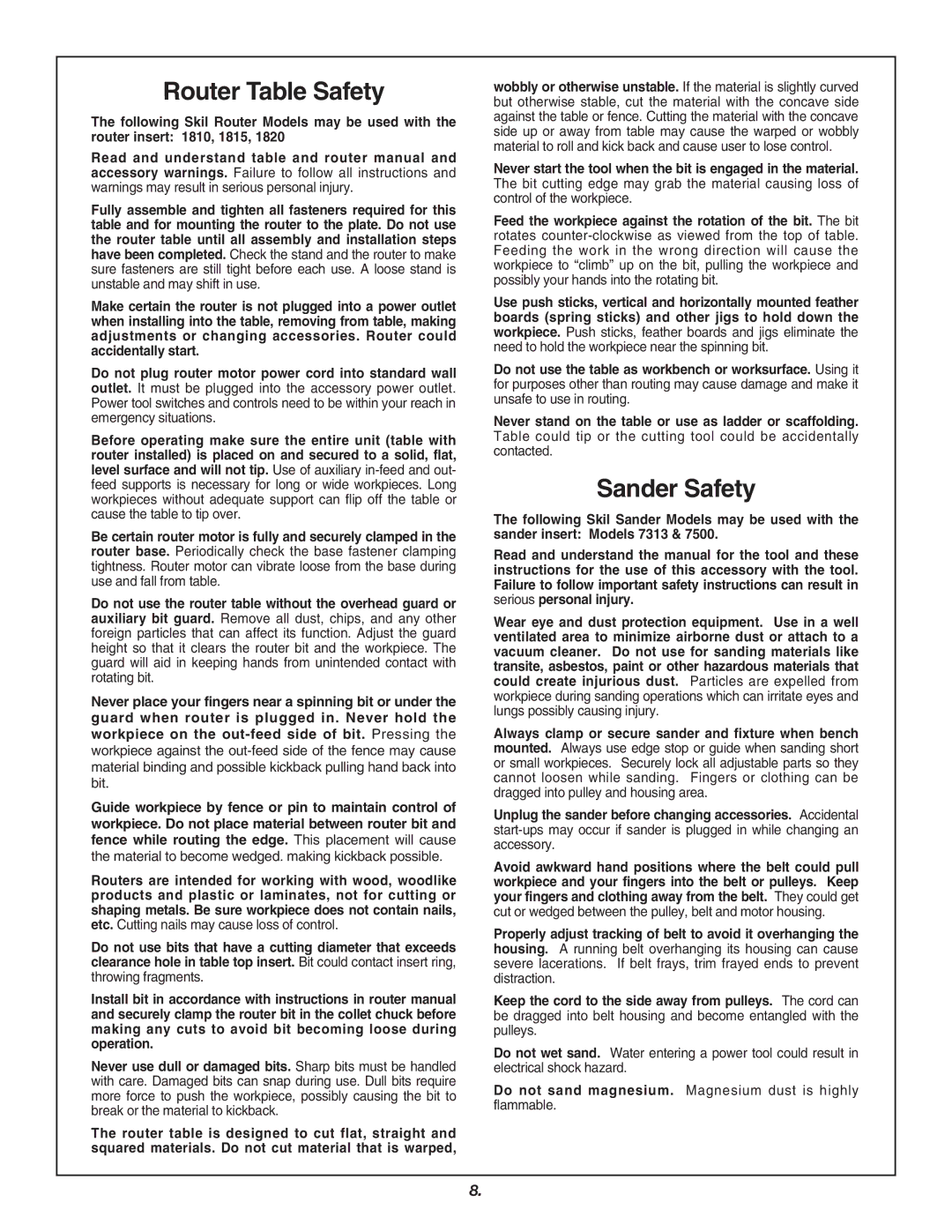
Router Table Safety
The following Skil Router Models may be used with the router insert: 1810, 1815, 1820
Read and understand table and router manual and accessory warnings. Failure to follow all instructions and warnings may result in serious personal injury.
Fully assemble and tighten all fasteners required for this table and for mounting the router to the plate. Do not use the router table until all assembly and installation steps have been completed. Check the stand and the router to make sure fasteners are still tight before each use. A loose stand is unstable and may shift in use.
Make certain the router is not plugged into a power outlet when installing into the table, removing from table, making adjustments or changing accessories. Router could accidentally start.
Do not plug router motor power cord into standard wall outlet. It must be plugged into the accessory power outlet. Power tool switches and controls need to be within your reach in emergency situations.
Before operating make sure the entire unit (table with router installed) is placed on and secured to a solid, flat, level surface and will not tip. Use of auxiliary
Be certain router motor is fully and securely clamped in the router base. Periodically check the base fastener clamping tightness. Router motor can vibrate loose from the base during use and fall from table.
Do not use the router table without the overhead guard or auxiliary bit guard. Remove all dust, chips, and any other foreign particles that can affect its function. Adjust the guard height so that it clears the router bit and the workpiece. The guard will aid in keeping hands from unintended contact with rotating bit.
Never place your fingers near a spinning bit or under the guard when router is plugged in. Never hold the workpiece on the
Guide workpiece by fence or pin to maintain control of workpiece. Do not place material between router bit and fence while routing the edge. This placement will cause the material to become wedged. making kickback possible.
Routers are intended for working with wood, woodlike products and plastic or laminates, not for cutting or shaping metals. Be sure workpiece does not contain nails, etc. Cutting nails may cause loss of control.
Do not use bits that have a cutting diameter that exceeds clearance hole in table top insert. Bit could contact insert ring,
throwing fragments.
Install bit in accordance with instructions in router manual and securely clamp the router bit in the collet chuck before making any cuts to avoid bit becoming loose during operation.
Never use dull or damaged bits. Sharp bits must be handled with care. Damaged bits can snap during use. Dull bits require more force to push the workpiece, possibly causing the bit to break or the material to kickback.
The router table is designed to cut flat, straight and squared materials. Do not cut material that is warped,
wobbly or otherwise unstable. If the material is slightly curved but otherwise stable, cut the material with the concave side against the table or fence. Cutting the material with the concave side up or away from table may cause the warped or wobbly material to roll and kick back and cause user to lose control.
Never start the tool when the bit is engaged in the material. The bit cutting edge may grab the material causing loss of control of the workpiece.
Feed the workpiece against the rotation of the bit. The bit rotates
Use push sticks, vertical and horizontally mounted feather boards (spring sticks) and other jigs to hold down the workpiece. Push sticks, feather boards and jigs eliminate the need to hold the workpiece near the spinning bit.
Do not use the table as workbench or worksurface. Using it for purposes other than routing may cause damage and make it unsafe to use in routing.
Never stand on the table or use as ladder or scaffolding. Table could tip or the cutting tool could be accidentally contacted.
Sander Safety
The following Skil Sander Models may be used with the sander insert: Models 7313 & 7500.
Read and understand the manual for the tool and these instructions for the use of this accessory with the tool. Failure to follow important safety instructions can result in serious personal injury.
Wear eye and dust protection equipment. Use in a well ventilated area to minimize airborne dust or attach to a vacuum cleaner. Do not use for sanding materials like transite, asbestos, paint or other hazardous materials that could create injurious dust. Particles are expelled from workpiece during sanding operations which can irritate eyes and lungs possibly causing injury.
Always clamp or secure sander and fixture when bench mounted. Always use edge stop or guide when sanding short or small workpieces. Securely lock all adjustable parts so they cannot loosen while sanding. Fingers or clothing can be dragged into pulley and housing area.
Unplug the sander before changing accessories. Accidental
Avoid awkward hand positions where the belt could pull workpiece and your fingers into the belt or pulleys. Keep your fingers and clothing away from the belt. They could get cut or wedged between the pulley, belt and motor housing.
Properly adjust tracking of belt to avoid it overhanging the housing. A running belt overhanging its housing can cause severe lacerations. If belt frays, trim frayed ends to prevent distraction.
Keep the cord to the side away from pulleys. The cord can be dragged into belt housing and become entangled with the pulleys.
Do not wet sand. Water entering a power tool could result in electrical shock hazard.
Do not sand magnesium. Magnesium dust is highly flammable.
8.
